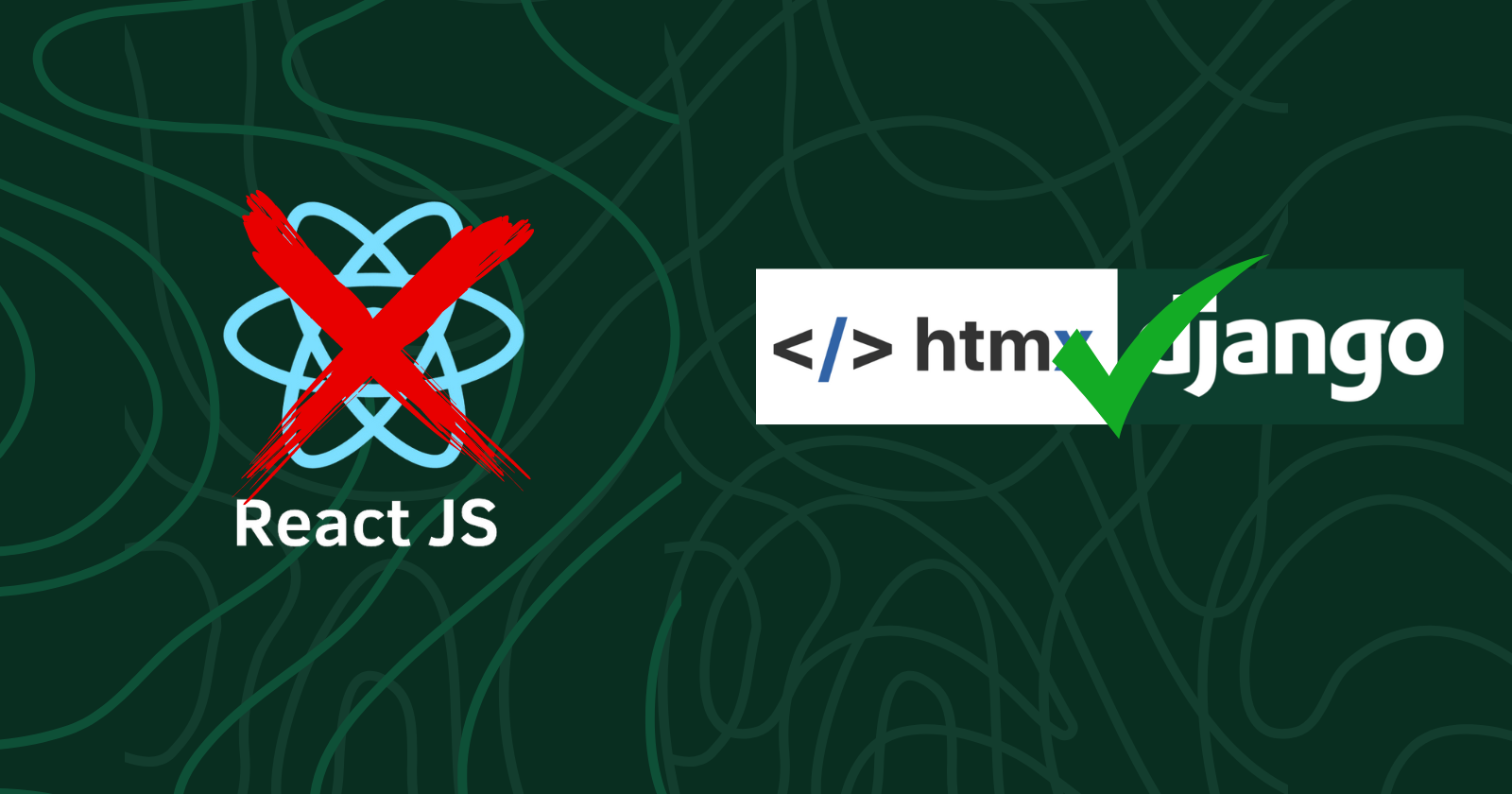Integrate HTMX with Django: Replacing ReactJS
 Nischal lamichhane
Nischal lamichhane
Introduction:
In the dynamic landscape of web development, staying abreast of the latest technologies is crucial. One such powerful combination is the integration of HTMX with Django, a blend that leverages modern websockets for enhanced real-time functionality. In this article, we'll delve into the world of HTMX and how it seamlessly integrates with Django to bring a new level of interactivity to your web applications.
Learn Python , HTMX & Django at django-tutorial.dev
Understanding HTMX:
HTMX, pronounced "hypertext marks," is a lightweight JavaScript library that facilitates seamless communication between the server and the client. Unlike traditional approaches, HTMX enables developers to update specific parts of a web page dynamically, without the need for a full-page reload. It achieves this by using AJAX requests, making it a powerful tool for creating responsive and interactive user interfaces.
Key Features of HTMX: Before we explore the integration of HTMX with Django, let's highlight some key features that make HTMX a valuable addition to your toolkit:
Declarative Syntax: HTMX employs a declarative syntax, allowing developers to define dynamic behavior directly in the HTML markup using data attributes. This simplifies the code and enhances readability, promoting a more intuitive development process.
AJAX Requests Simplified: By abstracting away the complexities of AJAX requests, HTMX streamlines the process of fetching and updating data from the server. This leads to cleaner code and a more efficient development workflow.
Compatibility with Django: HTMX aligns seamlessly with Django, making it an excellent choice for developers working within the Django ecosystem. Its compatibility extends to various Python frameworks, ensuring flexibility and ease of integration.
Integrating HTMX with Django:
Now, let's explore the steps to integrate HTMX with Django, specifically focusing on leveraging modern web sockets for real-time communication.
Installing HTMX: Begin by installing HTMX in your Django project. You can use package managers like pip to install the necessary dependencies. Ensure that HTMX is included in your project's static files. You can also use CDN for HTMX like this:
<script src="https://cdnjs.cloudflare.com/ajax/libs/htmx/1.9.10/htmx.min.js" ></script>Adding HTMX to Templates: Integrate HTMX into your Django templates by including the necessary script tags. HTMX utilizes data attributes to define behavior, so make sure to annotate the HTML elements that you want to enhance with dynamic functionality.
Setting Up Django Views: Update your Django views to handle the HTMX requests. This involves defining view functions that respond to specific HTMX-triggered actions. Use Django's robust capabilities to process data and return the appropriate response.
Incorporating Websockets: To harness the power of modern websockets, consider integrating Django Channels into your project. Django Channels extends Django to handle WebSockets, enabling bidirectional communication between the server and the client.
Real-Time Updates: With HTMX and Django Channels in place, you can achieve real-time updates on your web pages. For example, implement a chat application where messages are sent and received in real-time, providing a seamless and interactive user experience.
Benefits of the Integration: The integration of HTMX with Django, coupled with modern Servers, offers several benefits to developers and end-users alike:
Enhanced User Experience: Real-time updates create a more engaging and interactive user experience. Whether it's live notifications or dynamic content updates, users will appreciate the responsiveness of the application.
Reduced Server Load: By updating only the necessary parts of a page, HTMX reduces the server load compared to traditional full-page reloads. This optimization leads to a more efficient use of server resources.
Simplified Development: The declarative syntax of HTMX and the compatibility with Django streamline the development process. Developers can focus on building features without getting bogged down by complex AJAX implementations.
Scalability: Modern websockets, facilitated by Django Channels, pave the way for scalable and real-time applications. Whether you're building a collaborative editing tool or a live dashboard, the integration sets the stage for future scalability.
Here is a code snippet that demonstrates a simple implementation of HTMX with Django and real-time updates without using websockets. For the sake of brevity, we'll create a basic example of a real-time counter.
<!-- Django Template with HTMX Integration -->
<!DOCTYPE html>
<html lang="en">
<head>
<meta charset="UTF-8">
<meta http-equiv="X-UA-Compatible" content="IE=edge">
<meta name="viewport" content="width=device-width, initial-scale=1.0">
<title>HTMX and Django Real-Time Counter</title>
<!-- Include HTMX library -->
<script src="{% static 'htmx.min.js' %}" defer></script>
</head>
<body>
<!-- Counter Display -->
<h1 id="counter" hx-get="{% url 'get_counter' %}">{% block counter %}{% endblock %}</h1>
<!-- Button to Increment Counter -->
<button hx-post="{% url 'increment_counter' %}" hx-target="#counter" hx-swap="outerHTML">
Increment Counter
</button>
</body>
</html>
In this Django template, we have a simple layout with a heading displaying the current counter value and a button to increment the counter. Notice the usage of HTMX attributes like hx-get, hx-post, hx-target, and hx-swap for handling AJAX requests.
Now, let's create the Django views and URLs to handle these HTMX requests and manage the counter:
# Django Views
from django.shortcuts import render
from django.http import JsonResponse
counter_value = 0 # Initial counter value
def get_counter(request):
# View to retrieve the current counter value
return JsonResponse({'counter': counter_value})
def increment_counter(request):
# View to increment the counter and return the updated value
global counter_value
counter_value += 1
return JsonResponse({'counter': counter_value})
And the corresponding Django URLs:
# Django URLs (urls.py)
from django.urls import path
from .views import get_counter, increment_counter
urlpatterns = [
path('get_counter/', get_counter, name='get_counter'),
path('increment_counter/', increment_counter, name='increment_counter'),
# Add other URLs as needed
]
Make sure to include these URLs in your main urls.py file.
Polling with Django and HTMX:
Polling is when a client requests a particular piece of data at regular intervals (maybe every x seconds) and the server reverts with a usual response with the required data. This can be useful on an collaborative/team application, where a user's action needs to be reflected on other's screen. Below is an example:
![]()
Let's say we need to Implement a Kanban board in some sort of Development software. In a kanban board, anyone involved in the development should be able to transfer a to-do from one column to another. But having it accurately reflect on other developer's screen is hard. we can either have the user manually reload the page to see any changes or start setting up a websocket & debugging inevitable bugs in the websocket. Here HTMX is the best solution. We will do Poll the state of kanban board in regular intervals (2s).
<div class="htmx-poller"
hx-target="#board"
hx-swap="innerHTML"
hx-get="{% url 'get_board' board.id %}"
hx-trigger="every 2s"> </div>
<div id = "board" > </div>
In above code snippet. we are getting the the board from the server every 2s and replacing the response with whatever was inside the board div.
hx-target --> the element that is targetted for swapping with the response
hx-get --> sends a get req to the 'get_board' url
hx-swap --> specified what to do with pre existing html inside of the target element
hx-trigger --> specifies when the request should be sent
For our purpose. our web server's code should look like this:
#urls.py
from django import path
from views import get_board
urlpatterns = [
path('board/<int:id>',get_board,name='get_board'),
]
from django.shortcuts import render
def get_board(request,id):
#
#
return render(request,'path_to_board_component.html',context)
When we return render our board component, it will go to our hx-target which happens to be #board in our case and it will replace previously existing board
Conclusion:
Reject React.JS embrace HTMX
Subscribe to my newsletter
Read articles from Nischal lamichhane directly inside your inbox. Subscribe to the newsletter, and don't miss out.
Written by

Nischal lamichhane
Nischal lamichhane
There are always 2 ways to do something in Django. They are Django Master's WAY WRONG WAY